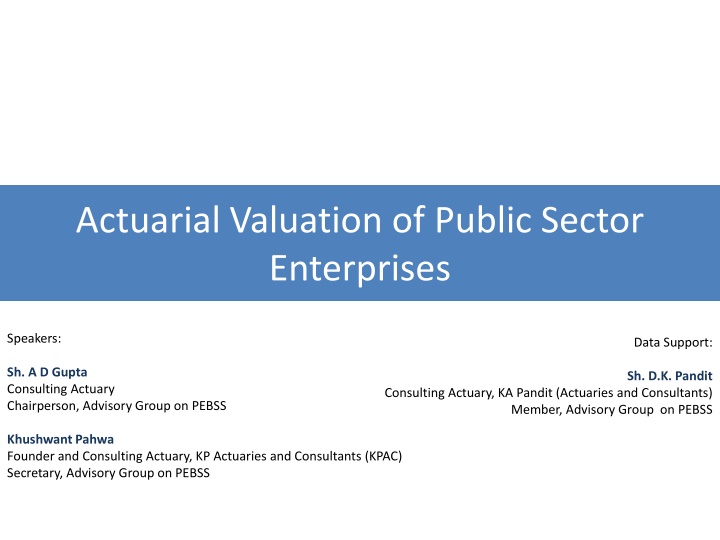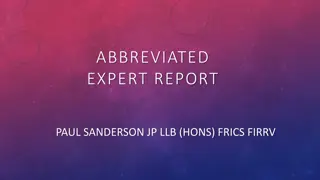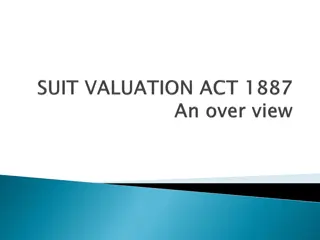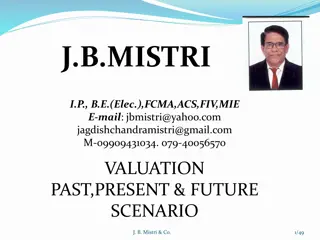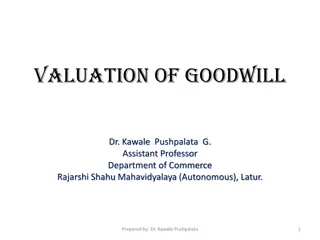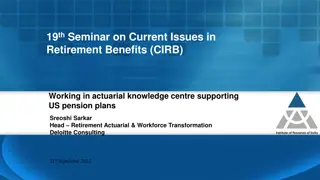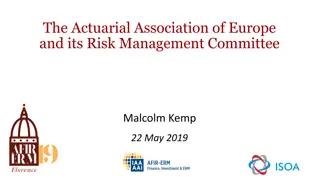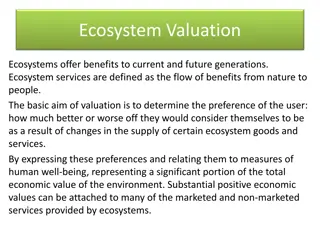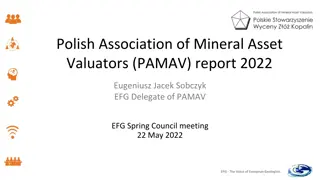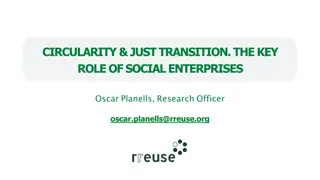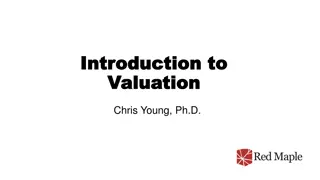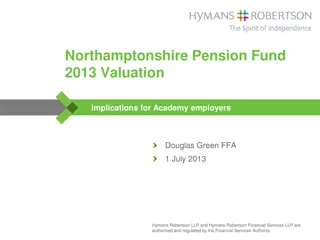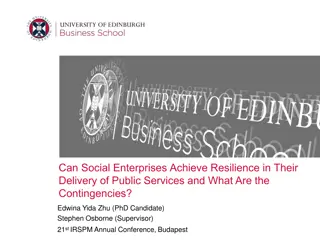Actuarial Valuation of Public Sector Enterprises Discussion
Public sector enterprises face challenges in addressing superannuation funding, salary assumptions, and reputation risks. The issues have been discussed in various forums with no immediate solutions, presenting potential opportunities. Insights from experts like Sh. A.D. Gupta and Sh. D.K. Pandit shed light on the complexities involved.
Download Presentation

Please find below an Image/Link to download the presentation.
The content on the website is provided AS IS for your information and personal use only. It may not be sold, licensed, or shared on other websites without obtaining consent from the author.If you encounter any issues during the download, it is possible that the publisher has removed the file from their server.
You are allowed to download the files provided on this website for personal or commercial use, subject to the condition that they are used lawfully. All files are the property of their respective owners.
The content on the website is provided AS IS for your information and personal use only. It may not be sold, licensed, or shared on other websites without obtaining consent from the author.
E N D
Presentation Transcript
Actuarial Valuation of Public Sector Enterprises Speakers: Data Support: Sh. A D Gupta Consulting Actuary Chairperson, Advisory Group on PEBSS Sh. D.K. Pandit Consulting Actuary, KA Pandit (Actuaries and Consultants) Member, Advisory Group on PEBSS Khushwant Pahwa Founder and Consulting Actuary, KP Actuaries and Consultants (KPAC) Secretary, Advisory Group on PEBSS
Agenda Introduction to the issue Identifying the problem Deliberating potential solutions Plan Assets Concluding remarks
Setting the context 1. Not a new issue. 2. Not a small issue. 3. Not an issue likely to go away soon. 4. Carries reputation risk? 5. Not immediate solution 6. Perhaps an opportunity?
Not a new issue Reputation Risk? Structural Solution? Not New Not Small Not Vanishing Opportunity? Not a new topic of discussion. Has been discussed in many forums (some mentioned below), Advisory Group and a topic of discussion in drafting of Actuarial Practice Standards. S. No. Seminar Topic Speaker 1 10th Seminar on Current Issues in Retirement Benefits (2014) Overview of research papers by the Institute of Actuaries a) Salary assumptions b) Public sector assumptions Vinod Kumar - Associate, IAI (Presenting) Kulin Patel - Director Client Account Management, Towers Watson (Facilitating) 2 Workshop Benefits (Pension) (2015) on Employee Public strengthening: How can we move Pension Benefit Liability? Sector Valuatio towards Y. P. Sabharwal, M. L. Sodhi, Nikhil Gupta, Anuradha Sehgal, Punit Jagtani 3 Global Actuaries (2015) Conference of Salary Trend in Public Sector Banks Vinod Kumar, Head of Research, IAI, India Chairperson: K K Wadhwa, Consulting Actuary, India 4 10th Seminar on Current Issues in Retirement Benefits (2016) Actuarial Valuation of Public Sector Enterprises A D Gupta Khushwant Pahwa
Not a new issue (Extracts of IBA 2013 circular) Reputation Risk? Structural Solution? Not New Not Small Not Vanishing Opportunity? Certain extracts of IBA Circular 2013 (Guidance to Banks): Regulatory displeasure over the lack of a planned approach to superannuation funding by many of the banks was expressed by the top management of RBI in their interactions with senior bankers under the aegis of IBA. RBI view was that any additional funding requirement on account of bipartite settlements should be anticipated and provided for without having to seek amortization facility as wage revision takes place every five years and a fair estimate could be made based on past trends as far as likely upward revision is concerned. Similarly, RBI felt that banks do not spread the yearly superannuation funding requirements evenly across the four quarters. Ballooned provisioning in the fourth quarter attracts criticisms from analysts and market watchers. Salary revision takes place on the basis of bipartite negotiations every five years. Possible future increases in the salary (basic plus DA) during the average remaining service of the employees will be reflected in the superannuation pay and hence need to be factored in while determining the SER. Banks may factor in this aspect appropriately in the calculations in consultation with their actuaries. Salary Escalation rate (SER) of 5-5.50% without taking into account future wage revisions could be considered reasonable. The SER would need to be adjusted substantially upwards to take into account future wage revisions.
Not a small issue Reputation Risk? Structural Solution? Not New Not Small Not Vanishing Opportunity? Despite IBA circular, impact of wage revisions / agreements not considered in valuations: Liability as at 31 March 2016 (Rs. in crores) Experience loss in last 3 years (Rs. crores) Assumed SGR Particulars Pension Gratuity Leave Total Pension Gratuity Leave Total State Bank of India 59,151 7,332 4,375 70,859 5.0% 14,945 511 N/A 15,456 Canara Bank 9,339 1,640 894 11,873 5.5% N/A N/A N/A N/A Central Bank of India 11,153 1,490 N/A 12,643 5.0% N/A N/A N/A N/A Bank of India 11,076 1,371 625 13,073 5.5% 1,299 (567) N/A 732 Union Bank of India 9,619 1,110 N/A 10,729 5.0% 2,792 103 N/A 2,895 Total actuarially valued liabilities for PSU banks may be to the tune of Rs. 150,000 to Rs. 2,00,000 crores. If salary growth rate assumption of 8% p.a. were to be considered appropriate, the above provisions may be higher by 20% to 30% (assuming duration of liability to be around 10 years). Overall, the potential strengthening needed for PSU banks alone may be to the tune of Rs. 40,000 crores to Rs. 60,000 crores (a gestimate!). Story of Public Sector Enterprises, other than banks, not very different.
Not a small issue Reputation Risk? Structural Solution? Not New Not Small Not Vanishing Opportunity? Below chart gives comparison of liabilities (other than unit fund) for life insurance companies in India with Employee Benefit liabilities for some PSU Bank and PSUs: Employee Benefit Liabilities vs Insurance non linked liabilities (Rs. crores) 70,859 80,000 39,033 40,000 24,085 19,459 19,443 16,642 13,073 12,643 11,873 10,729 9,209 8,966 6,759 6,612 6,579 5,686 5,683 5,186 5,124 4,919 3,023 2,778 2,272 2,066 1,718 1,654 1,051 882 761 594 376 -
Not a small issue Reputation Risk? Structural Solution? Not New Not Small Not Vanishing Opportunity? Amount of strengthening needed by PSU banks more than the funds allocated in Union Budget 2016 to address the NPA issue. Clearly a call for action!
Not Vanishing.in fact may become more challenging Reputation Risk? Structural Solution? Not New Not Small Not Vanishing Opportunity?
Potentially carries reputation risk. Reputation Risk? Structural Solution? Not New Not Small Not Vanishing Opportunity? Dear Sir, While carrying out the Actuarial valuation for leave encashment and Gratuity, assumptions for Salary increase and Interest earned are being made by you. In this connection we are in receipt of a query from Department of Public Enterprises which is reproduced as under:- It has been brought to the attention of DPE by Comptroller and Auditor General of India (C&AG) that C&AG, during the course of audit, have observed that there was a wide variation between the actual rate of increase in salary over a period of time and the rate of increase adopted for actuarial valuation while making provisions for leave encashment and gratuity. They have also mentioned that provisions made on inappropriate valuation worked out at a lesser rate goes to pad up the profits of the Company and to that extent does not represent a true and fair picture. You are requested to kindly give your views on the above observation specifically with respect to the assumptions made by you while carrying out actuarial valuation of Leave Encashment and Gratuity of ______. ___________
Needs a long term solution.surely. Reputation Risk? Long Term Solution? Not New Not Small Not Vanishing Opportunity? Profitability not there to absorb hit that may arise out of corrections: Liability as at 31 March 2016 (Rs. in crores) PAT FY2015-16 (Rs. in crores) Particulars Pension Gratuity Leave Total State Bank of India 59,151 7,332 4,375 70,859 9,951 Canara Bank 9,339 1,640 894 11,873 -2,812 Central Bank of India 11,153 1,490 N/A 12,643 -1,418 Bank of India 11,076 1,371 625 13,073 -6,089 Union Bank of India 9,619 1,110 N/A 10,729 1,352 For banks, priority will be sorting out NPA issues. Post sorting out NPA issues, scope may not be there to absorb strengthening of employee benefit provisions. Surely, the issue cannot be resolved in one year. Actuaries need to work with Companies / Management s to work out 3-year or 5-year strengthening plan.
An opportunity to work with the government? Reputation Risk? Structural Solution? Not New Not Small Not Vanishing Opportunity? Opportunity to work with the government and help these enterprises strengthen. Opportunity to highlight and showcase the importance of our profession. Ind ASs may present an opportunity as the entire strengthening may not be routed through Income Statement. On pensions and gratuity, same will be routed through Other Comprehensive Income (OCI).
Agenda Introduction to the issue Identifying the problem Deliberating potential solutions Plan Assets Concluding remarks
Issues with PSU Valuations Issues with PSU Valuations Salary Growth Rate Assumption Mortality / Longevity Assumption Provision of inadequate liability? Issue of salary growth rate being inadequate, resulting in under-provisioning of the liability. Issue of use of old mortality table and non allowance of mortality improvements. Is this really an issue? Issue also of use of assured lives table for valuing Pensions / PRMS Schemes
Considering Salary hikes in the past Total Basic + DA 4,232 4,524 4,866 7,740 8,088 8,775 9,556 10,584 11,765 19,035 20,316 21,924 26,920 27,987 29,638 31,907 31,873 Overall Increase Total Basic + DA 33,603 34,631 36,185 42,315 61,700 64,028 69,193 76,956 79,230 91,656 103,146 114,391 125,195 143,244 156,320 164,355 Overall Increase 5% 3% 4% 17% 46% 4% 8% 11% 3% 16% 13% 11% 9% 14% 9% 5% Year Total Basic DA Year Total Basic DA 1/1/1990 1/1/1991 8/1/1991 1/1/1992 4/1/1992 1/1/1993 1/1/1994 1/1/1995 1/1/1996 1/1/1997 4/1/1997 1/1/1998 1/1/1999 1/1/2000 1/1/2001 1/1/2002 3/1/2002 3,930 4,070 4,350 7,740 7,990 8,310 8,640 8,985 9,345 19,035 20,115 20,880 21,675 22,300 22,940 23,600 23,575 302 454 516 - 98 465 916 1,599 2,420 - 201 1,044 5,245 5,687 6,698 8,307 8,298 1/1/2003 1/1/2004 1/1/2005 1/1/2006 1/1/2007 4/1/2007 1/1/2008 1/1/2009 3/1/2009 1/1/2010 1/1/2011 1/1/2012 1/1/2013 1/1/2014 1/1/2015 1/1/2016 23,900 23,900 23,900 26,765 61,700 63,520 65,400 66,000 67,950 70,020 72,130 73,000 73,000 75,190 75,190 77,380 9,703 10,731 12,285 15,550 - 508 3,793 10,956 11,280 21,636 31,016 41,391 52,195 68,054 81,130 86,975 7% 8% 59% 4% 8% 9% 11% 11% 62% 7% 8% 23% 4% 6% 8% 0% CAGR of Salary between 2007 and 2016 = 12% CAGR of Salary between 2007 and 2016 = 11.5% CAGR of Salary between 2007 and 2016 = 14.1% CAGR of Salary between 2006 and 2016 = 14.5%
Considering Salary hikes in the past Total Basic + DA Overall Increase Total Basic + DA Overall Increase Year Year 1/1/1990 4,232 1/1/2003 33,603 5% 1/1/1991 4,524 7% 1/1/2004 34,631 3% 8/1/1991 4,866 8% 1/1/2005 36,185 4% 1/1/1992 7,740 59% 1/1/2006 42,315 17% 4/1/1992 8,088 4% 1/1/2007 61,700 46% CAGR of Salary = 9.8% p.a. 1/1/1993 8,775 8% 4/1/2007 64,028 4% 1/1/1994 9,556 9% 1/1/2008 69,193 8% Average CPI = 8.4% p.a. 1/1/1995 10,584 11% 1/1/2009 76,956 11% 1/1/1996 11,765 11% 3/1/2009 79,230 3% CAGR of Salary = 11.5% p.a. 1/1/1997 19,035 62% 1/1/2010 91,656 16% 4/1/1997 20,316 7% 1/1/2011 103,146 13% Average CPI = 9% p.a. 1/1/1998 21,924 8% 1/1/2012 114,391 11% CAGR of Salary =9.5% p.a. 1/1/1999 26,920 23% 1/1/2013 125,195 9% 1/1/2000 27,987 4% 1/1/2014 143,244 14% Average CPI = 5.2% p.a. 1/1/2001 29,638 6% 1/1/2015 156,320 9% 1/1/2002 31,907 8% 1/1/2016 164,355 5% 3/1/2002 31,873 0%
CPI and Bond Yields Discount Rate (Bond Yields) are a given for valuation. We can estimate consistent long term view of CPI to be about 1.5% to 2% lower. Building on the Merit Component and Productivity Component may get us to a sound salary growth rate assumption.
Issue with Mortality Assumption: Longevity IALM: 2006-08 vs 1994-96 Mortality Rates 0.06 Mortality Rate 0.03 IALM2006-08 IALM1994-96 0 51 52 53 54 55 56 57 58 59 60 61 62 Age 63 64 65 66 67 68 69 70 71 72 73 % Improvement 40% 31%32%34% 29% 30% 27% 24% 22% 20%21% 19% 18% 20% 16% 14% 10%10%10%12% 9% 8% 7% 10% 7% 6% 6% 0% 51 52 53 54 55 56 57 58 59 60 61 62 63 64 65 66 67 68 69 70 71 72 73
Issue with Mortality Assumption The table below shows the impact of 15% and 20% improvement in Annuitant s rates on life expectancy: Life Expectancy Increase in life expectancy % increase in remaining life expecancy Age Base 15% improvement 60 65 70 75 80 80.7 81.8 83.2 85.1 87.6 82.1 83.2 84.4 86.2 88.6 1.5 1.4 1.3 1.1 1.0 7.1% 8.1% 9.6% 11.3% 13.1% Life Expectancy Increase in life expectancy % increase in remaining life expecancy Age Base 20% improvement 60 65 70 75 80 80.7 81.8 83.2 85.1 87.6 82.7 83.7 84.9 86.6 89.0 2.0 1.9 1.8 1.6 1.4 9.8% 11.3% 13.3% 15.7% 18.3% A 20% improvement in mortality rates may result in an increase in liability by more than 10% (ignoring impact of salary growth rate and discount rate).
Agenda Introduction to the issue Identifying the problem Deliberating potential solutions Plan Assets Concluding remarks
Deliberating solutions The Way Forward Actually solving the problem Protecting ourselves Any guidance needed? By use of adequate disclosures and disclaimers to highlight areas of concern. Preparing 3 year or 5 year plans to strengthen the provisioning. Specific guidance for PSU valuations may end up being rule based and not principles based. Sheer magnitude of problem means that it cannot be solved overnight. Taking management representations on inputs into the valuations. Do we need such a guidance?
Protecting ourselves In determination of assumptions, the roles of various stakeholders is as follows: Stakeholder Role in determination of Assumptions Valuing Actuary Advice Management Decide Auditor Concur / Agree (Refer SA500: Audit Evidence) Clarifying Responsibility: Actuarial valuation reports contain many inputs (data, assumptions, benefit). We must clarify, for each set of input individually, the extent to which we have relied and / or verified. Reflecting Discharge of Responsibility: Valuation report should bring out that the Management / Company has been advised by the Company on appropriate set of assumptions. Reflecting Disagreement: If appropriate set of assumptions have not been chosen, the same should be reflected in the report. Overall, the Standard Disclaimers currently contained in the reports may not be enough to make the user of the report understand exactly what are we owning up to and what are the responsibilities of the user of the report.
Potential disclaimers on Salary Growth Rate Assumptions The Company has been advised that the assumptions need to be set up based on Para 73 to Para 91 of AS15 (Revised 2005). Specifically for Salary Growth Rate assumption, the Company has been advised to choose an assumption that adequately considers the three key components of the salary growth i.e. inflation relief, productivity increase and merit increase. The Company has been advised to also consider the past trends in salary growth rate in choosing the salary growth rate assumption for the purposes of this valuation. The assumptions, including the Salary Growth Rate assumption, considered in this valuation have been selected by the management of the Company. It should be noted that Salary Growth Rate is one the key assumptions used in determination of the liability. An increase in salary growth rate assumption by 1% p.a. i.e. from 5% p.a. currently to 6% p.a. will lead to an increase in liability by 10% i.e. from Rs. 30,000 crores currently to Rs. 33,000 crores. Past trends are an important factor to be considered in determining the salary growth rate assumption. Observing the past trends in the salary growth of employees over the last 15 years (which includes the impact one wage revision agreement) indicates that the chosen salary growth rate assumption does not adequately reflect the increases in salary growth expected to be given in future. If this report is being made available to auditors and they are expected to rely on the numbers contained herein, then, in light of provisions of para _____ of SA 500: Audit Evidence issued by the Institute of Chartered Accountants of India, it must be indicated to that they continue to be responsible for validity of data and reasonableness of the assumptions.
What about Mortality / Longevity? Clients cannot be responsible for Mortality Rate assumptions. It is the actuary that must be responsible. Need to move to Annuitants table, if not already doing it. Start applying improvement factors, if not already doing it. May be 5% each year as a sudden large improvement may push up the liabilities too much. If nothing, we should highlight / make relevant statements, such as: Mortality table used in the valuation is based on annuitants data of years 1996 to 1998. It does not factor in the improvements in mortality and consequent increase in life expectancy that may have happened ever since. The valuation also does not consider the future improvements in life expectancy, that may happen until the benefit payout under the scheme. It may be noted that a 10% improvement in mortality experience over and able the published table currently used for valuation, which is likely to result in an increase in life expectancy of a 60 years old person by about 1 year, is likely to result in an increase in liability by 5%.
Creating strengthening plans Two Approaches Protect yourself Engage to Solve Problem cannot be solved overnight. Can be solved over medium term, if approached proactively Must do, in any case Use of Disclaimers Help companies create 3-year or 5-year or longer plans to strengthening, whilst continuing to protect yourself. Taking Management Representations Consider all factors in creating such plans i.e. interest rates fall, increase in gratuity limit, mortality improvements, strengthening of salary growth rate assumptions. Documenting conversations and discussions Creating minutes of critical meetings, even if telephonic Benefits: Commercial interests, greater interaction with the organizations, minimizes professional / reputational risks and helps serve the interests of public. Challenges: of the other approach will include low profitability of the companies and reluctance on their part to take incremental hits on their profitability. However, CAG findings and routing of re-measurements through Other Comprehensive Income (OCI) can help sell the idea.
Need for professional guidance? Need a Standard for PSU valuations? Need for profession to engage with DPE? Need support from AG on drafting disclaimers / qualifications to consider? Need for mandating Peer Review of liabilities of PSUs? Any other support needed from AG? Any other thoughts?
Agenda Introduction to the issue Identifying the problem Deliberating potential solutions Plan Assets Concluding Thoughts
Restrictions on what can be Plan Assets FUNDING Reporting Enterprise Gratuity Trust INVESTED (Non Transferable financial instrument of the reporting enterprise) Such investment cannot be treated as Plan Asset! 7.15 Assets held by a long-term employee benefit fund are assets (other than non-transferable financial instruments issued by the reporting enterprise) that: (a) (b) are available to be used only to pay or fund employee benefits, are not available to the reporting enterprise s own creditors (even in bankruptcy), and cannot be returned to the reporting enterprise, unless either:
Restrictions on what can be Plan Assets FUNDING Reporting Enterprise Gratuity Trust Such investment cannot be treated as Plan Asset! Insurance Company 7.16 A qualifying insurance policy is an insurance policy issued by an insurer that is not a related party (as defined in AS 18 Related Party Disclosures) of the reporting enterprise, if the proceeds of the policy:
Consider including disclaimer for above May consider incorporating some disclaimer regarding plan assets in the report. Examples: Information relating to Plan Assets contained in this report, including the fair value of plan assets as at the valuation date, has been provided to me by the Company. The same has not been verified or validated by me. I have not verified whether the qualifying conditions for Plan Assets, as indicated in AS15 Employee Benefits, have been met.
Agenda Introduction to the issue Identifying the problem Deliberating potential solutions Plan Assets Concluding remarks
Concluding thoughts Issue too large to be ignored or considered lightly. We must seek to protect ourselves and the reputation of our profession. We must ensure audit trails, documentation, management representations and adequate disclaimers / qualifications in our reports. We must be able to prove discharge of our advisory responsibility. We may engage proactively with clients to create strengthening plans. If need is felt, should the profession engage with DPE to help protect actuaries and help companies create strengthening plan? Please write to AG on PEBSS for any questions / suggestions / recommendations in this regard. You may write to compliance@actuariesindia.org.
